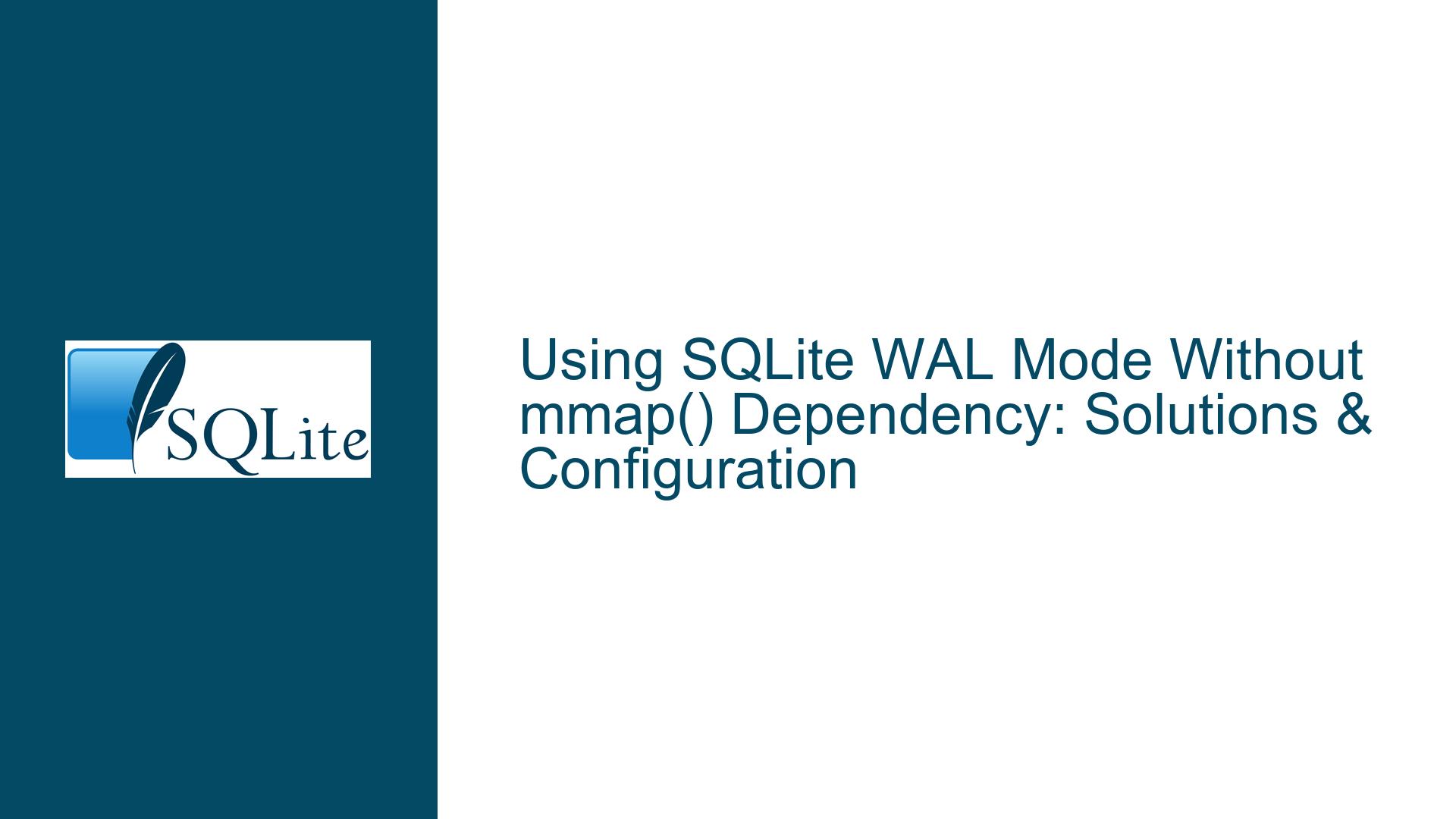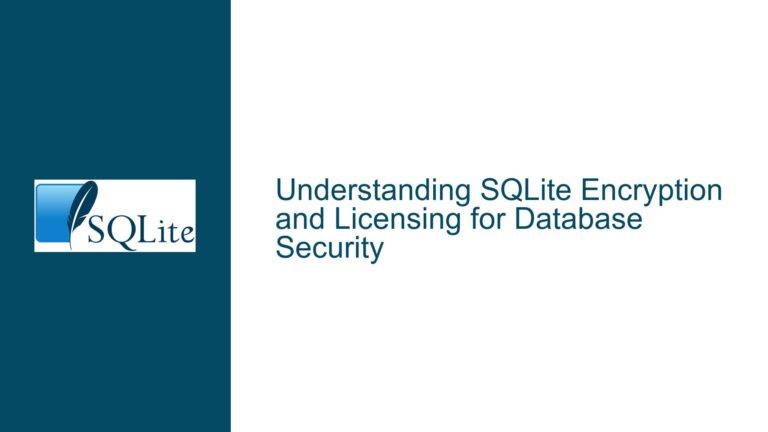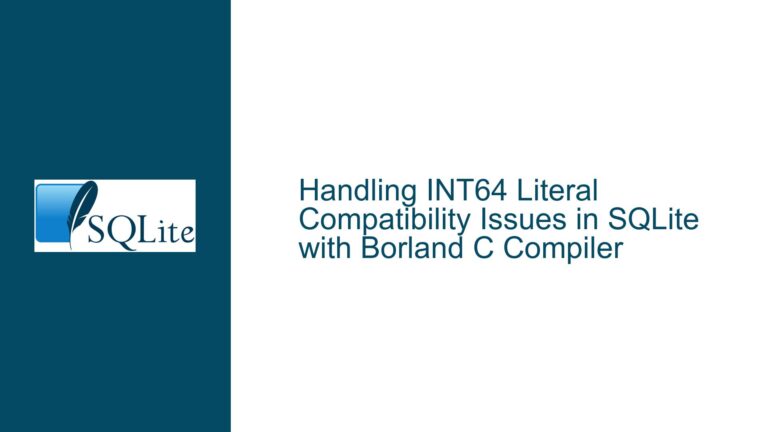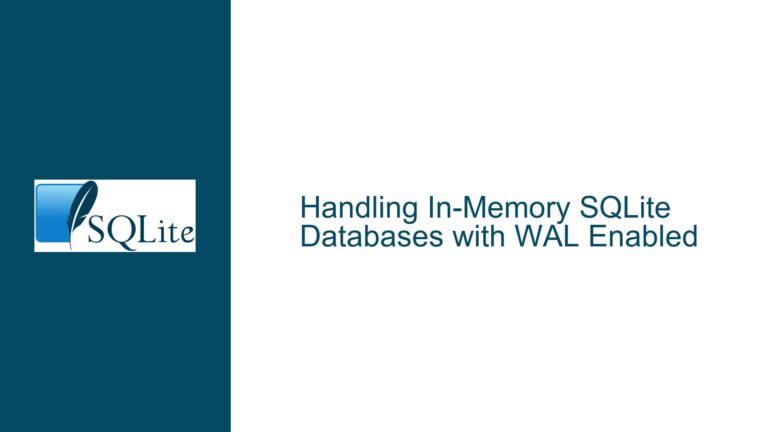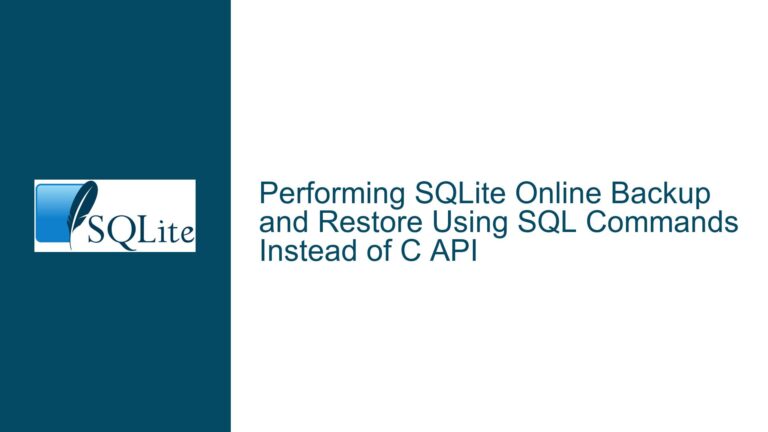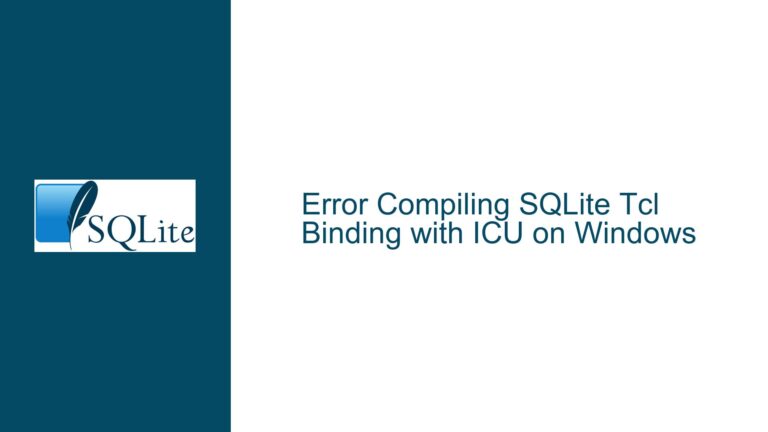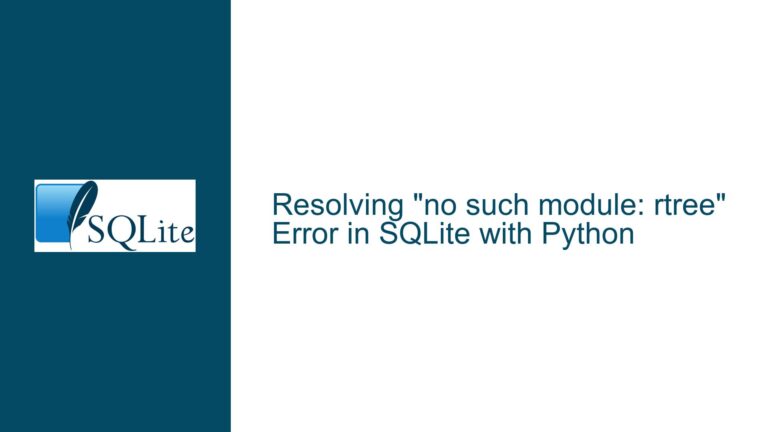Using SQLite WAL Mode Without mmap() Dependency: Solutions & Configuration
WAL Mode and mmap() Interdependencies: Isolation, Configuration, and Customization
WAL Mode Functionality and mmap() Dependency Constraints
SQLite’s Write-Ahead Logging (WAL) mode is designed to improve concurrency and performance by allowing readers to operate on a consistent snapshot of the database while writers append changes to a separate WAL file. A critical component of WAL’s design is the use of shared memory (the "-shm" file) to coordinate access between multiple processes. This shared memory is traditionally managed via the mmap() system call, which maps the shared memory file into the process’s address space. However, in environments where mmap() is unavailable, unsuitable, or restricted (e.g., real-time operating systems like VxWorks in kernel mode), this dependency becomes problematic.
The core issue arises from SQLite’s internal linkage to mmap() when WAL mode is enabled, even in configurations where shared memory is not required. Specifically, when a database is opened in exclusive locking mode (SQLITE_OPEN_EXCLUSIVE), SQLite bypasses the use of shared memory because only one process can access the database. Despite this, the SQLite codebase conditionally links mmap() if either SQLITE_OMIT_WAL is undefined or SQLITE_MAX_MMAP_SIZE is greater than zero. This creates a contradiction: developers may intend to use WAL in exclusive mode without shared memory, yet the build process still requires mmap() symbols, leading to linker errors or runtime failures in environments lacking mmap().
Root Causes of mmap() Dependency in WAL Mode
1. Compile-Time Configuration Flags Misalignment
SQLite’s behavior is heavily influenced by preprocessor macros. The SQLITE_MAX_MMAP_SIZE macro controls whether memory-mapped I/O is enabled. Setting this to 0 disables mmap entirely. However, if WAL mode is not explicitly omitted (via SQLITE_OMIT_WAL), the SQLite build process will still reference mmap() in the system call table. This occurs because the WAL implementation shares code paths with the memory-mapped I/O subsystem, even when shared memory is not used in exclusive mode. The conditional compilation logic in sqlite3.c (as shown in the discussion) binds mmap() linkage to the absence of SQLITE_OMIT_WAL or a non-zero SQLITE_MAX_MMAP_SIZE.
2. Exclusive Locking Mode and Shared Memory Assumptions
When a database is opened in exclusive locking mode, SQLite assumes that only one process will access the database, rendering shared memory unnecessary. However, the WAL subsystem does not automatically disable all shared memory abstractions; it merely skips creating or accessing the -shm file. The internal data structures and APIs that manage WAL still rely on the mmap() function for initializing memory regions, even if those regions are never populated from a file. This creates an implicit dependency on mmap() unless the build explicitly excludes WAL.
3. VFS Layer and Platform-Specific Constraints
SQLite’s Virtual File System (VFS) layer abstracts platform-specific operations, including file locking and memory mapping. In environments like VxWorks kernel mode, traditional process isolation and POSIX-compliant mmap() may not exist. The default VFS implementations assume the availability of mmap() for shared memory operations, even when they are not strictly necessary. If the VFS does not override the xShmMap, xShmLock, and xShmBarrier methods, SQLite will fall back to using mmap(), regardless of the locking mode.
Resolving mmap() Dependency: Configuration, Customization, and Testing
Step 1: Compile-Time Configuration for mmap() Exclusion
To eliminate mmap() linkage, two macros must be defined during compilation:
SQLITE_MAX_MMAP_SIZE=0: Disables all memory-mapped I/O.SQLITE_OMIT_WAL: Removes WAL mode entirely (not ideal if WAL is required).
If WAL mode is necessary, SQLITE_OMIT_WAL cannot be used. Instead, ensure SQLITE_MAX_MMAP_SIZE=0 and configure the database to use exclusive locking mode. However, as noted in the discussion, this may still leave mmap() symbols unresolved. To address this, modify the SQLite amalgamation code to decouple WAL from mmap():
// In sqlite3.c, locate the syscall section:
#if !defined(SQLITE_OMIT_WAL) || SQLITE_MAX_MMAP_SIZE>0
{ "mmap", (sqlite3_syscall_ptr)mmap, 0 },
#else
{ "mmap", (sqlite3_syscall_ptr)0, 0 },
#endif
// Force the else branch by defining both:
#define SQLITE_MAX_MMAP_SIZE 0
#define SQLITE_OMIT_WAL 0
This ensures the mmap syscall pointer is NULL, but WAL remains enabled. Note that this requires careful testing, as undocumented dependencies on mmap() may exist.
Step 2: Enforce Exclusive Locking Mode and Disable Shared Memory
When opening the database, use SQLITE_OPEN_EXCLUSIVE to prevent shared memory usage:
sqlite3_open_v2("database.db", &db, SQLITE_OPEN_READWRITE | SQLITE_OPEN_CREATE | SQLITE_OPEN_EXCLUSIVE, NULL);
Additionally, execute the following pragmas after opening the connection:
PRAGMA locking_mode = EXCLUSIVE;
PRAGMA journal_mode = WAL;
Exclusive locking mode ensures no -shm file is created, bypassing shared memory. However, the WAL index (a data structure to track readers and writers) is still stored in heap memory. In SQLite’s default configuration, this index uses mmap()-derived memory even when not backed by a file. To override this, a custom VFS is required.
Step 3: Implement a Custom VFS for Non-mmap() Shared Memory
In environments where mmap() is unavailable but all threads/processes share a global address space (e.g., VxWorks kernel mode), implement a custom VFS that replaces shared memory methods:
static int vxworksShmMap(
sqlite3_file *file,
int iPg,
int pgsz,
int bExtend,
void volatile **pp
){
// Allocate shared memory from global heap
void *p = kernelAlloc(pgsz); // VxWorks-specific allocation
*pp = p;
return SQLITE_OK;
}
static int vxworksShmLock(sqlite3_file *file, int offset, int n, int flags){
// Use kernel-level semaphores or spinlocks
return SQLITE_OK;
}
static void vxworksShmBarrier(sqlite3_file *file){
// Memory barrier implementation, if required
}
// Register the custom VFS
sqlite3_vfs *pVxworksVfs = sqlite3_vfs_find(NULL);
pVxworksVfs->xShmMap = vxworksShmMap;
pVxworksVfs->xShmLock = vxworksShmLock;
pVxworksVfs->xShmBarrier = vxworksShmBarrier;
sqlite3_vfs_register(pVxworksVfs, 1);
This custom VFS replaces mmap()-based shared memory with direct heap allocations, leveraging the kernel’s global memory visibility. Ensure that memory barriers and locks are implemented appropriately for atomicity and consistency.
Step 4: Validate WAL Functionality Without mmap()
After applying the above steps, conduct rigorous testing:
- Check for mmap() Linker Errors: Ensure no unresolved symbols for mmap(), munmap(), or related functions.
- Verify WAL File Operations: Confirm that writes generate -wal files but no -shm files.
- Concurrency Tests: In exclusive mode, only one writer/reader should be allowed. Attempting concurrent access should fail with
SQLITE_BUSY. - Recovery Testing: Forcefully terminate the process and reopen the database to ensure WAL checkpointing works without shared memory.
Step 5: Edge Cases and Platform-Specific Adjustments
- Memory Allocation Alignment: In custom VFS implementations, ensure allocated memory is aligned to the SQLITE_DEFAULT_MMAP_SIZE boundary (typically 4096 bytes).
- File Locking: In VxWorks, replace POSIX advisory locks with kernel-level locks using
semTake()/semGive(). - WAL Index Persistence: Without a -shm file, the WAL index is reinitialized on each open. Ensure that transaction IDs and frame counters are managed correctly during recovery.
By methodically reconfiguring compile-time settings, enforcing exclusive locking, and customizing the VFS layer, developers can successfully decouple SQLite’s WAL mode from mmap() dependencies. This approach is critical for embedded systems and real-time operating systems where POSIX functions are restricted or absent.
